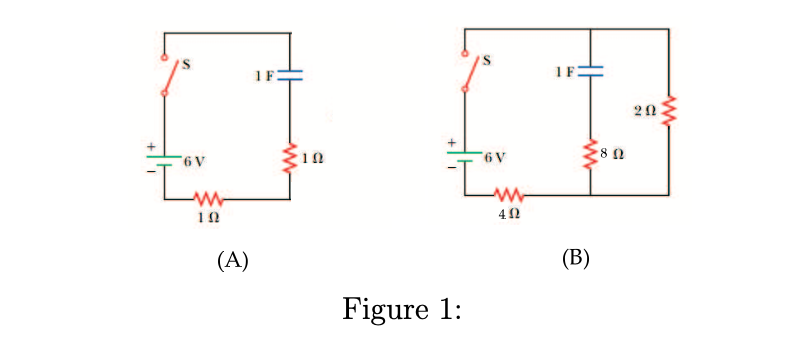1. Refer to figure 1.A. The capacitor is initially uncharged. The switch S is closed at t = 0 (a) The time constant of the circuit is RC = (20) (1F) = 2sec (True, False) (b)After a very long time (t –) the voltage and charge of the capacitor are 6.0V and 6.0C respectively. (True, False) (c) At t = 0+ the voltage across each in resistor is 3.0V. (True, False) (d)At t = 0+ the conduction current through the resistors and the displacement current through the capacitor are 3A and 3A respectively. (True, False)
1. Refer to figure 1.A. The capacitor is initially uncharged. The switch S is closed at t = 0 (a) The time constant of the circuit is RC = (20) (1F) = 2sec (True, False) (b)After a very long time (t –) the voltage and charge of the capacitor are 6.0V and 6.0C respectively. (True, False) (c) At t = 0+ the voltage across each in resistor is 3.0V. (True, False) (d)At t = 0+ the conduction current through the resistors and the displacement current through the capacitor are 3A and 3A respectively. (True, False)
Physics for Scientists and Engineers: Foundations and Connections
1st Edition
ISBN:9781133939146
Author:Katz, Debora M.
Publisher:Katz, Debora M.
Chapter24: Electric Fields
Section24.2: Special Case: Electric Field Of A Charged Sphere
Problem 24.1CE: In a few sentences, explain how you know that E(r)=(kQs/r2)r (Eq. 24.3) is consistent with Figure...
Related questions
Question

Transcribed Image Text:1F
IF
6V
6 V
10
(A)
(B)
Figure 1:

Transcribed Image Text:1. Refer to figure 1.A. The capacitor is initially uncharged. The switch S is closed at t = 0
(a) The time constant of the circuit is RC = (20)(1F) = 2sec
(True, False)
(b)After a very long time (t - 0) the voltage and charge of the capacitor are 6.0V and 6.0C respectively.
(True, False)
(c)At t = 0+ the voltage across each 12 resistor is 3.0ov.
(True, False)
(d)At t = 0+ the conduction current through the resistors and the displacement current through the capacitor are 3A and 3A respectively.
(True, False)
Expert Solution
This question has been solved!
Explore an expertly crafted, step-by-step solution for a thorough understanding of key concepts.
This is a popular solution!
Trending now
This is a popular solution!
Step by step
Solved in 5 steps with 5 images

Knowledge Booster
Learn more about
Need a deep-dive on the concept behind this application? Look no further. Learn more about this topic, physics and related others by exploring similar questions and additional content below.Recommended textbooks for you

Physics for Scientists and Engineers: Foundations…
Physics
ISBN:
9781133939146
Author:
Katz, Debora M.
Publisher:
Cengage Learning

Physics for Scientists and Engineers with Modern …
Physics
ISBN:
9781337553292
Author:
Raymond A. Serway, John W. Jewett
Publisher:
Cengage Learning

Principles of Physics: A Calculus-Based Text
Physics
ISBN:
9781133104261
Author:
Raymond A. Serway, John W. Jewett
Publisher:
Cengage Learning

Physics for Scientists and Engineers: Foundations…
Physics
ISBN:
9781133939146
Author:
Katz, Debora M.
Publisher:
Cengage Learning

Physics for Scientists and Engineers with Modern …
Physics
ISBN:
9781337553292
Author:
Raymond A. Serway, John W. Jewett
Publisher:
Cengage Learning

Principles of Physics: A Calculus-Based Text
Physics
ISBN:
9781133104261
Author:
Raymond A. Serway, John W. Jewett
Publisher:
Cengage Learning

College Physics
Physics
ISBN:
9781938168000
Author:
Paul Peter Urone, Roger Hinrichs
Publisher:
OpenStax College